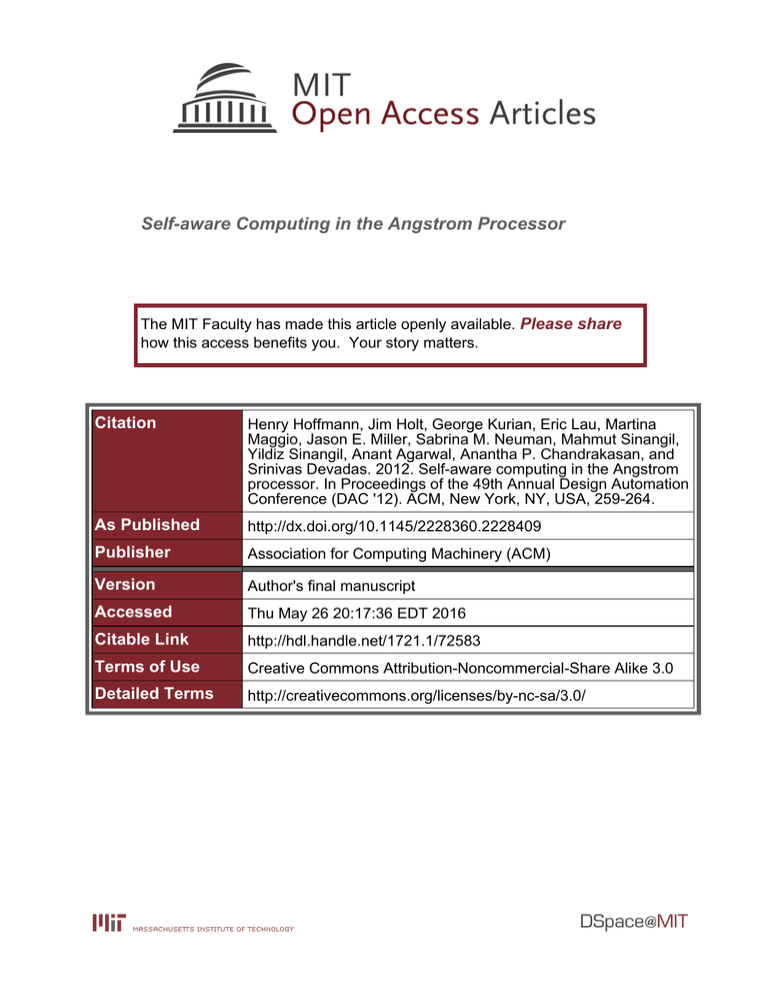Self-aware Computing in the Angstrom Processor Please share
advertisement

Self-aware Computing in the Angstrom Processor
The MIT Faculty has made this article openly available. Please share
how this access benefits you. Your story matters.
Citation
Henry Hoffmann, Jim Holt, George Kurian, Eric Lau, Martina
Maggio, Jason E. Miller, Sabrina M. Neuman, Mahmut Sinangil,
Yildiz Sinangil, Anant Agarwal, Anantha P. Chandrakasan, and
Srinivas Devadas. 2012. Self-aware computing in the Angstrom
processor. In Proceedings of the 49th Annual Design Automation
Conference (DAC '12). ACM, New York, NY, USA, 259-264.
As Published
http://dx.doi.org/10.1145/2228360.2228409
Publisher
Association for Computing Machinery (ACM)
Version
Author's final manuscript
Accessed
Thu May 26 20:17:36 EDT 2016
Citable Link
http://hdl.handle.net/1721.1/72583
Terms of Use
Creative Commons Attribution-Noncommercial-Share Alike 3.0
Detailed Terms
http://creativecommons.org/licenses/by-nc-sa/3.0/
Self-aware Computing in the Angstrom Processor
Henry Hoffmann1
Jim Holt1,2
George Kurian1
Eric Lau1
Martina Maggio3
Jason E. Miller1
Sabrina M. Neuman1
Mahmut Sinangil4
Yildiz Sinangil4
Anant Agarwal1
Anantha P. Chandrakasan4
Srinivas Devadas1
1
MIT Computer Science and Artificial Intelligence Laboratory 2 Freescale Semiconductor
3
Lund University 4 MIT Microsystems Technology Laboratories
1
{hank,jholt,gkurian,elau,jasonm,sneuman,agarwal,devadas}@csail.mit.edu, 2 jim.holt@freescale.com
3 maggio.martina@gmail.com, 4 {sinangil,koken,anantha}@mit.edu
ABSTRACT
Addressing the challenges of extreme scale computing requires holistic design of new programming models and systems that support those models. This paper discusses the
Angstrom processor, which is designed to support a new
Self-aware Computing (SEEC) model. In SEEC, applications explicitly state goals, while other systems components
provide actions that the SEEC runtime system can use to
meet those goals. Angstrom supports this model by exposing sensors and adaptations that traditionally would be
managed independently by hardware. This exposure allows
SEEC to coordinate hardware actions with actions specified
by other parts of the system, and allows the SEEC runtime
system to meet application goals while reducing costs (e.g.,
power consumption).
Categories and Subject Descriptors
C.1.3 [Other Architectural Styles]: Adaptable architectures
General Terms
Performance, Design, Experimentation
Keywords
Adaptive Systems, Self-aware Computing
1.
INTRODUCTION
The constraints and complexity of extreme-scale computing systems make them extremely difficult to program. This
difficulty arises partly from a need to meet multiple – often
competing – goals, such as maximizing performance while
This work was funded by the U.S. Government under the DARPA
UHPC program. The views and conclusions contained herein are
those of the authors and should not be interpreted as representing
the official policies, either expressed or implied, of the U.S. Government.
Permission to make digital or hard copies of all or part of this work for
personal or classroom use is granted without fee provided that copies are
not made or distributed for profit or commercial advantage and that copies
bear this notice and the full citation on the first page. To copy otherwise, to
republish, to post on servers or to redistribute to lists, requires prior specific
permission and/or a fee.
DAC 2012, June 3-7,2012, San Francisco, California, USA.
Copyright 2012 ACM ACM 978-1-4503-1199-1112/06 ...$10.00.
Figure 1: The Observe-Decide-Act loop in SEEC.
minimizing energy consumption. Additional difficulty stems
from the fact that these systems are increasingly dynamic
and must continue to function in the face of both dramatically changing application workloads and unreliable, failureprone components.
Programming extreme scale systems to meet multiple constraints and modify behavior in the face of unforeseen events
is a challenge beyond most application developers. Doing so
requires expertise in the application domain, but also a deep
systems knowledge to balance performance against competing goals like power efficiency. In addition, adjusting to dynamic fluctuations, such as workload variance or component
failure, requires further knowledge in the design and implementation of adaptive systems.
The Angstrom project [29] addresses the challenge of programming extreme-scale systems by supporting a novel selfaware computing model, called SEEC [15]. SEEC makes it
easy to create self-adaptive, or autonomic, computing systems which can alter their behavior to meet multiple goals
and automatically adapt to environmental changes. Like all
self-adaptive systems, SEEC is characterized by the presence of an observe-decide-act, or ODA, loop [18, 23]. The
Angstrom system continuously monitors its goals (observe)
and available resources (actions) using a decision engine to
determine how best to use resources to meet goals (decide)
given the current state of the system.
One of the unique features of Angstrom compared to prior
work in adaptive systems is that every component of the system, from applications to hardware, is designed to support
adaptation as a first-class object. In practice, this means
that these components all contribute to the specification of
the observe-decide-act loop as illustrated in Figure 1. In this
model, applications use one interface to specify goals (e.g.,
a video encoder should run at thirty frames per second),
while system software and hardware use a separate interface
to specify actions (e.g., allocating processing cores, changing cache configuration). A runtime decision system then
determines how to use the available actions to meet goals
while reducing cost.
This paper provides an overview of the SEEC model and
describes the current design of the Angstrom processor, with
a focus on those features that explicitly support SEEC. Angstrom is a proposed 1000-core, massively manycore processor that supports self-aware computing by exposing a wide
array of actions (in the form of different hardware configurations) and observations (including both traditional performance counters [34] and energy counters [31]) to the SEEC
runtime system. Simulations of 256 core Angstrom systems
show that exposing hardware adaptation to a software management system has the potential to improve performance
per watt by an average of over 100% compared to a nonadaptive system.
The rest of this paper is organized as follows. Section 2
discusses related work in adaptive computing. Section 3
summarizes the SEEC model, while Section 4 describes the
Angstrom processor’s support for this model. Section 5
presents an evaluation of the SEEC model on both an existing system and on simulations of future Angstrom systems.
The paper concludes in Section 6.
2.
BACKGROUND
Self-aware, or autonomic, computing has been proposed
as one method to deal with the rising complexity of computer systems [18, 23], and adaptive systems have been implemented in both hardware [2, 5, 10, 11] and software [32].
One limitation of these approaches is that they typically do
not support adaptation as a first-class object. Instead, they
propose closed adaptive systems that are not accessible by
other components of the system. While this approach completely insulates application programmers from the complexity of adaptive system design, it can lead to other difficulties. Specifically, many hardware-based approaches assume
a fixed set of adaptations, which exist exclusively in hardware and are unable to incorporate application specific goals.
Similarly, many software-based approaches assume that the
hardware is fixed and thus make no attempt to coordinate
with lower-level adaptations.
As an example of a closed adaptive hardware system, consider the resource manager described by Bitirgen et al [5].
This system uses a neural network to allocate resources to a
multi-programmed multicore system, with a goal of optimizing total system throughput, or total number of programs
completed. This system does an excellent job of coordinating resources to meet goals, but it works with a fixed set
of hardware resources and optimizes only a fixed goal of total system throughput. This system would not be able to
incorporate additional adaptations specified at the software
level or work with application specific goals (like achieving
a desired frame rate for a video encoder).
To illustrate the problems of composing closed adaptive
systems, we present the following experiment. Using the
Graphite simulator [28], we run the barnes application from
the SPLASH2 benchmark suite on a multicore system with
two possible adaptations: the total number of cores assigned
to it (from 1-64, by powers of 2), and the size of the L2-cache
on each core (from 16-256 KB, by powers of 2). For each
combination of core allocation and cache size, we measure
Figure 2: Efficiency of closed adaptive systems.
the performance of the application and the total energy consumed. The results are shown in Figure 2, where the x-axis
shows energy and the y-axis shows instructions per second.
The solid diamond points represent all tested configurations.
The squares show configurations that appear optimal for a
closed system which only considers cache adaptations. The
triangles show possible configurations for a system that only
considers core allocations. The best configurations are the
ones with highest performance and lowest total energy; i.e.,
the Pareto-optimal frontier which is depicted by those diamond points that are connected by a line in the figure.
Notice that both triangles and squares appear to the right
of the Pareto frontier, and these points represent configurations that closed systems would believe to be optimal, but,
in fact, are sub-optimal for the overall system.
To avoid sub-optimal configurations, the SEEC model provides a general interface allowing adaptations supported by
different system components to be described by their designer and then manipulated by the SEEC runtime decision
system. For example, this interface can be used to describe
both operating system-level actions (e.g., allocation of cores
to an application [26]) and hardware-level actions (e.g., reconfiguration of the hardware data cache [4]). Given this
information, the SEEC runtime system can coordinate adaptation to keep the system on the Pareto optimal curve shown
in Figure 2. To support this model, hardware must be explicitly designed to expose adaptations instead of attempting
to adapt as a closed system.
3.
THE SEEC MODEL
The key feature of the SEEC model is its open ODA loop
where different components of the system contribute to the
specification of observations, actions, and decisions. This
section summarizes the model; more detailed information is
available in [15].
3.1
Observe
In order to change something, it is essential to measure
the value to be changed. In SEEC, applications explicitly state their goals and other system components measure
whether those goals are being met. SEEC uses the Application Heartbeats API [14] to specify application goals and
progress. The API’s key abstraction is a heartbeat; applications use a function to emit heartbeats at important intervals, while additional API calls specify goals in terms of
this heartbeat. SEEC currently supports three application
specified goals: performance, accuracy, and power. Performance is specified as a target heart rate or a target latency
between specially tagged heartbeats. Accuracy goals are
specified as a distortion, or linear distance from an application defined nominal value [16], measured over some set
of heartbeats. Power and energy goals can be specified as
target average power for a given heartrate or as a target
energy between tagged heartbeats. All goals are expressed
using a C/C++API so that applications can explicitly state
these goals. A second API allows other components of the
system to observe the current value of any of these metrics
and thus evaluate whether or not the goals are being met.
3.2
Act
In the SEEC model, applications provide goals while system components specify actions that change the behavior
of the system. SEEC supports a range of actions specified
from the application-level [3, 16], system software level [12,
25], and the hardware level as exposed by the Angstrom
processor (see Section 4).
As discussed in Section 2, SEEC works to avoid suboptimal combinations of actions by providing an interface that
all system components use to specify available actions. This
interface must be general enough to support actions exposed
by different developers working at different levels of the system stack. Actions are specified by describing the actuators
that implement them. In SEEC, an actuator is a data object with: a name, a list of allowable settings, a function that
changes the setting, a set of axes which the actuator affects
(e.g., performance and power), and the effects of each setting on each axis. These effects are listed as multipliers over
a nominal setting, whose effects are 1 on all axes. Each actuator specifies a delay, which is the time between when it is
set and when its effects can be observed. Finally, each actuator specifies whether it works on only the application that
registered it or if it works on all applications, so that SEEC
can distinguish between adaptations specified at applicationlevel (e.g., changing algorithms) and adaptations that affect
the whole system (e.g., allocating cores).
3.3
Decide
SEEC’s runtime system automatically and dynamically
selects actions to meet goals while attempting to minimize
cost. The SEEC decision engine is designed to handle general-purpose environments and the SEEC runtime system
will often have to make decisions about actions and applications with which it has no prior experience. In addition,
the runtime system will need to react quickly to changes in
application load and fluctuations in available resources. To
meet these requirements for handling general and volatile
environments, the SEEC decision engine is designed with
multiple layers of adaptation as described in [15]. At the
lowest-level, SEEC acts as a classical control system, taking
feedback, in the form of heartbeats, and using it to tune
actuators to meet goals [26]. The classical control system
works well given prior knowledge about the application’s behavior. Additional layers of adaptation, including adaptive
control and machine learning based techniques [27], allow
the SEEC runtime to allocate resources efficiently without
prior knowledge of the application, or when the behavior of
the actuator diverges from the predicted behavior.
4.
ANGSTROM SUPPORT FOR SEEC
Angstrom is a manycore system design targeting the integration of 1000 cores onto a single chip. A full description
of the design is beyond the scope of this paper, so we focus
on features of the architecture explicitly designed to support
the SEEC model.
4.1
Observation
The Angstrom processor design supports SEEC by providing visibility into the hardware in the form of traditional performance counters, event probes, and non-traditional sensors. This information allows SEEC’s runtime decision engine to diagnose either why goals are not being met, or
whether there might be a lower cost set of actions that would
achieve the same goal.
Performance counters provide valuable insight into the behavior of an application on a particular hardware architecture. Unfortunately, many existing systems limit the number of counters that can be read simultaneously by software. This limitation means that application tuning requires
multiple profiling runs and prevents dynamic exploitation
of performance counter information. The Angstrom design
exposes multiple performance counters that are memorymapped and can be read by any level of the software stack.
These count simple events such as: memory operations,
cache hits and misses, pipeline stall cycles, network flits sent
and received, etc. These are useful for assessing average behavior over a period of time but since they must be polled
by software, they cannot be queried too frequently.
To reduce the overhead of monitoring the performance
counters and watch for rare events, Angstrom’s design includes event probes, that can be associated with a performance counter or some other piece of state with the processor. They contain a trigger register and a programmable
comparator that continually watches for the state to match
the trigger. The comparator can be set to different operations including: equal, less than, greater than and their
logical inverses. In addition, a mask can be specified to
compare only selected bits. When a match occurs, an interrupt can be generated or an event record can be placed in a
small hardware queue.
Besides observing processor state, Angstrom includes sensors to monitor things like temperature, voltage, battery
charge, and energy consumption [31]. This allows the runtime decision engine to react to changing environmental conditions (such as cooling failures or dying batteries) as well
as observe how its actions impact these quantities to handle
goals like minimizing power consumption or limiting temperature extremes. We expect some of these sensors to be
deployed in a fine-grained manner to measure variations between the 1000 cores.
4.2
Action
As further support for the SEEC model, the Angstrom
processor exposes a number of different actions or different hardware configurations. Keeping with the theme of
building an open adaptive system, Angstrom provides these
“knobs” but relies on the SEEC runtime system to set them
in coordination with other adaptations specified at the software level. This section discusses some of the adaptations
exposed by the Angstrom processor at both the intra- and
inter-core level.
4.2.1
Intra-core Adaptation
In the Angstrom design, each core is capable of running at
different voltages and frequencies. Operating the processor
designs at lower voltage levels has been shown to increase energy efficiency, as with the voltage-scalable 32-bit microprocessor design demonstrated in [17]. This processor operates
at peak performance with nominal voltages while supporting
an energy efficient mode at 0.54 V with only 10.2 pJ/cycle
energy consumption. Similarly, making each Angstrom core
capable of running at different voltage and frequency levels will optimize them for applications with limited energy
budgets and time varying processing loads.
Technology scaling is fueling integration of larger on chip
caches in processor design (e.g., up to 50 MB [30]). In order to enable ultra-low power consumption, Angstrom cores
need to feature voltage-scalable SRAMs. Conventional SRAMs cannot work at low-voltage levels due to stability problems. Thus, recent work has focused on implementing different bit-cell topologies [7, 6] and peripheral assist circuits
[21, 33] to enable operation down to sub-VT levels.
Reconfiguration of the local caches is shown to reduce
power consumption for the same performance [4]. Disabling
unnecessary parts of the Angstrom caches (sets and ways)
will help SEEC to optimize power and performance tradeoffs. This adaptation can be beneficial both for applications
with small working sets and applications with large working
sets that do not achieve much locality on their data.
4.2.2
Inter-core Adaptations
Angstrom supports dynamic adaptation of the on-chip
network by enabling software and hardware to interact in
achieving goal-driven tradeoffs between performance and efficiency. This is accomplished with three architecture features: express virtual channels (EVC) [8], bandwidth adaptive networks (BAN) [9], and application-aware oblivious
routing (AOR) [22].
EVC allows flits to attempt bypassing of buffering and
arbitration within a network router by proceeding straight
to switch and link traversals. This can significantly reduce
latency and can also reduce energy spent in buffering flits.
Previous EVC research has demonstrated significant performance/energy tradeoff capability; Angstrom enhances this
by introducing a software interface to routing tables maintained in the network hardware. This information is then
used by EVC logic to manage virtual channels.
A BAN can rapidly adjust bisection bandwidth to adapt
to changing network conditions. This is done by using bidirectional links with arbitration logic and tristate buffers
that prevent simultaneous writes to the same wire. A hardware bandwidth allocator governs the direction of a link.
Angstrom expands on prior BAN approaches by exposing
configuration parameters in the bandwidth allocator to software while still providing for fine-grained bandwidth management in hardware.
AOR algorithms can produce deadlock-free routes while
maximizing satisfaction of flow demands on the network,
achieving better throughput than traditional oblivious routing approaches because optimization is done using global application knowledge. At the same time the router remains
simple because routes are configured via a routing table.
Unlike previous offline routing algorithm approaches, Angstrom provides for online routing computation by exposing
the routing table to software, allowing the system to adapt
to changing application characteristics over time.
Angstrom also supports adaptation of the cache-coherence
protocol used between cores. For some applications, direc-
tory-based cache-coherence provides the best performance
and energy consumption [13]. However, for other applications it is more efficient to use a shared-NUCA (non-uniform
cache access) protocols because it provides for a large shared
cache capacity and reduces the total number of off-chip accesses [20]. The ARCc architecture has shown that combining these protocols and adaptively selecting the best on
a per application basis can improve performance and energy efficiency [19]. Angstrom adopts the ARCc approach
of providing multiple coherence protocols and exposes these
adaptations to SEEC for management.
4.3
Decision
Although self-aware optimizations are capable of dramatically improving the behavior of applications, they do not
come for free. Some resources must be devoted to making
runtime decisions to have a dynamic, adaptive system. To
help reduce the costs of runtime decision making the Angstrom processor contains specialized, low-power cores called
partner cores, which we describe below. More detail is available in [24].
Each main core in the Angstrom design has a partner core
associated with it. These two cores are tightly integrated so
that the partner core can inspect and manipulate state (including performance counters and configuration registers)
within the main core. The partner core also has access to
the event queues fed by event probes. The partner core targets a lower performance point than the main core and is
designed to take much less area and energy. It has a simplified pipeline, smaller caches and fewer functional units. It is
designed to run at lower clock frequencies and makes heavy
use of low-power circuit techniques, requiring less energy per
operation, and making it more efficient to run dynamic optimization code on the partner core than the main core. We
estimate that each partner core will consume about 10% of
the area and 10% of the power of a main core.
5.
EVALUATION
This section presents experiments designed to evaluate the
SEEC model and highlight the benefits of Angstrom’s support for it. We first use SEEC to control applications on an
existing Linux/x86 system. We then collect data on simulations of a 256 core Angstrom processor and use that data to
build analytical models that predict how SEEC will behave
on such a system.
5.1
Benchmark Applications
Both experiments use the same set of five benchmark
applications selected from the SPLASH2 benchmark suite:
barnes, ocean (non contiguous), raytrace, water (spatial),
and volrend [35]. Each application is instrumented with the
Application Heartbeats API to emit goals. In both experiments, applications request a target performance and SEEC
is tasked with meeting that performance while minimizing
power consumption.
5.2
SEEC on Existing Systems
We begin by presenting results using SEEC to control
these benchmarks on an existing architecture with some
adaptive capabilities, but which was not explicitly designed
to support SEEC. Specifically, we use a Dell PowerEdge
R410 server with two quad-core Intel Xeon E5530 processors
running Linux 2.6.26. The processors support seven power
Figure 3: SEEC on a Linux/x86 system.
states with clock frequencies from 2.4 GHzto 1.6 GHz. The
cpufrequtils package enables software control of the clock
frequency (and thus the power state). We use a WattsUp
device to sample and store the average consumed power over
1 second intervals [1]. All benchmark inputs have been expanded to allow them to run for significantly more than 1
second. The measured power ranges from 220 watts (at full
load) to 80 watts (idle), with a typical idle power consumption of approximately 90 watts.
Each benchmark is launched on a single core set to the
minimum clock speed and it requests a performance equal
to half the maximum achievable. SEEC’s runtime attempts
to meet this application specified performance goal while
minimizing power consumption using the following actions:
changing the number of cores assigned to the application,
changing the clock speed of the cores assigned to an application, and changing the number of active (or non-idle)
cycles assigned to the application. For each application, we
measure the average performance and power consumption
over the entire execution of the application. We then subtract out the idle power of the processor and compute performance per Watt as the minimum of the achieved and desired
performance divided by the power beyond idle.
To show the benefits of SEEC we compare to several
other approaches. First, we compute the best that could be
achieved in a system with no adaptation; i.e., when all applications use the same number of cores and the same clock
speed, which provides a baseline that any adaptive system
should hope to beat. Next, we compare to a system where
adaptation is uncoordinated ; i.e., separate instances of the
SEEC runtime system control cores, clock speed, and idle cycles but do not coordinate with each other. Uncoordinated
adaptation represents what happens when multiple closed
adaptive systems work together. Third, we compare to a
static oracle, which adapts resource usage to the individual
application, but only assigns resources once per application.
The static oracle represents what is possible with an adaptive system which does not make fine-grained adaptation.
Finally, we compare to a dynamic oracle which adapts resource allocation at every heartbeat to the best configuration
for the application’s next heartbeat. Obviously, the dynamic
oracle cannot be built in practice, but instead its actions are
computed after the fact by post processing empirical data
for each application. The dynamic oracle represents an upper bound on the possible benefits of adaptation because it
has 1) no overhead and 2) perfect knowledge of the future.
The results of this experiment are shown in Figure 3,
where benchmarks are labeled on the x-axis and performance
per Watt is on the y-axis. For each benchmark, performance
Figure 4: Anticipated SEEC results on Angstrom.
per Watt is normalized to that achieved by the dynamic oracle (so the maximum possible is one). Separate bars show
the value achieved for each approach of: no adaptation, uncoordinated adaptation, SEEC, and dynamic oracle.
The results show the benefits of using SEEC to provide coordinated management of adaptive systems. SEEC is able
to outperform the uncoordinated adaptive system by over
20% and the static oracle by over 15%. Indeed, for some applications, uncoordinated adaptation is actually worse than
not adapting because uncoordinated adaptations oscillate
through suboptimal resource allocations. In contrast, the
SEEC model exposes these adaptations as first class objects
so it can coordinate and avoid suboptimal configurations.
SEEC is able to achieve almost 94% of the performance of
the dynamic oracle, which demonstrates that SEEC is responsive and low overhead.
5.3
SEEC on Angstrom
This section explores the benefits of running SEEC on a
future Angstrom architecture with 256 cores. We use the
Graphite simulator [28] to model an Angstrom processor
that can adapt its cache size (from 32-128 KB, by powers
of 2), the number of cores assigned to an application (from
1-256, by powers of 2), and the voltage (0.4, 0.8 V) and
frequency (100, 500 MHz) of those cores. We use simulation
because existing processors do not have as many cores or
available adaptations.
We run each benchmark in every possible configuration
and use this data to compute the performance per watt as
described above and construct the performance of a system
with no adaptation, and the performance of a system which
adapts using the static oracle. We then compute the predicted value of using SEEC by multiplying the value of the
static oracle by the multiplier that SEEC achieved on the
x86 architecture in the above section.
The results for this experiment are shown in Figure 4.
This figure shows the benchmark on the x-axis and the performance per Watt on the y-axis. For each benchmark, performance per Watt is normalized to that achieved by the predicted SEEC result. Separate bars show the value achieved
for: no adaptation, the static oracle, and our estimate of
how SEEC will behave on the Angstrom architecture.
The results show that the Angstrom architecture indeed
benefits more from adaptation than modern architectures,
because of the increased number of available adaptations.
As a specific example, barnes contains large amounts of par-
allelism that can be exploited by allocating cores, but that
is not the case for all applications. In fact, the non-adaptive
system allocates 64 cores out of a possible 256 to the system
because it provides the best average performance per watt
efficiency across all applications. On the other hand, a static
oracle allocates 256 cores for running barnes, outperforming
the non-adaptive configuration by over 5x.
Overall, the static oracle outperforms the non-adaptive
system by 72% on average. Under the assumption that
SEEC outperforms the static oracle by 15%, we predict that
SEEC on the Angstrom architecture can achieve an improvement of 100% over a standard non-adaptive system. Indeed,
future manycore architectures that are designed explicitly
to leverage the self-aware computing model will enjoy SEEC
considerably more than current systems.
6.
CONCLUSION
This paper has presented the design for the Angstrom architecture. Angstrom is a multicore which addresses the
challenge of extreme-scale computing by explicitly supporting a self-aware computational model. This support comes
in two forms. First, Angstrom provides additional visibility into the hardware state through performance and energy
counters. Second, Angstrom exposes hardware adaptations
so that they can be managed by the SEEC runtime system
in coordination with other, software based actions. We have
demonstrated how self-aware computing provides a benefit
on existing architectures and presented evidence that this
approach will provide an even greater benefit when implemented on an architecture like Angstrom with explicit support for the model.
7.
REFERENCES
[1] Wattsup .net meter. http://www.wattsupmeters.com/.
[2] D. H. Albonesi, R. Balasubramonian, S. G. Dropsho,
S. Dwarkadas, E. G. Friedman, M. C. Huang, V. Kursun,
G. Magklis, M. L. Scott, G. Semeraro, P. Bose,
A. Buyuktosunoglu, P. W. Cook, and S. E. Schuster.
Dynamically tuning processor resources with adaptive
processing. Computer, 36:49–58, December 2003.
[3] J. Ansel, C. Chan, Y. L. Wong, M. Olszewski, Q. Zhao,
A. Edelman, and S. Amarasinghe. PetaBricks: A language and
compiler for algorithmic choice. In PLDI, 2009.
[4] R. Balasubramonian, D. Albonesi, A. Buyuktosunoglu, and
S. Dwarkadas. Memory hierarchy reconfiguration for energy
and performance in general-purpose processor architectures. In
MICRO, 2000.
[5] R. Bitirgen, E. Ipek, and J. F. Martinez. Coordinated
management of multiple interacting resources in chip
multiprocessors: A machine learning approach. In MICRO,
2008.
[6] B. Calhoun and A. Chandrakasan. A 256kb sub-threshold
SRAM in 65nm CMOS. In ISSCC, 2006.
[7] L. Chang, D. Fried, J. Hergenrother, J. Sleight, R. Dennard,
R. Montoye, L. Sekaric, S. McNab, A. Topol, C. Adams,
K. Guarini, and W. Haensch. Stable SRAM cell design for the
32 nm node and beyond. In Symposium on VLSI Technology,
2005.
[8] C.-H. O. Chen, N. Agarwal, T. Krishna, K.-H. Koo, L.-S. Peh,
and K. C. Saraswat. Physical vs. Virtual Express Topologies
with Low-Swing Links for Future Many-core NoCs. In NOCS,
2010.
[9] M. H. Cho, M. Lis, K. S. Shim, M. Kinsy, T. Wen, and
S. Devadas. Oblivious Routing in On-Chip
Bandwidth-Adaptive Networks. In PACT, 2009.
[10] S. Choi and D. Yeung. Learning-Based SMT Processor
Resource Distribution via Hill-Climbing. In ISCA, 2006.
[11] C. Dubach, T. M. Jones, E. V. Bonilla, and M. F. P. O’Boyle.
A predictive model for dynamic microarchitectural adaptivity
control. In MICRO, 2010.
[12] J. Eastep, D. Wingate, M. D. Santambrogio, and A. Agarwal.
Smartlocks: lock acquisition scheduling for self-aware
synchronization. In ICAC, 2010.
[13] A. Gupta, W. Weber, and T. Mowry. Reducing memory and
traffic requirements for scalable directory-based cache
coherence schemes. In ICPP, 1990.
[14] H. Hoffmann, J. Eastep, M. D. Santambrogio, J. E. Miller, and
A. Agarwal. Application heartbeats: a generic interface for
specifying program performance and goals in autonomous
computing environments. In ICAC, 2010.
[15] H. Hoffmann, M. Maggio, M. D. Santambrogio, A. Leva, and
A. Agarwal. SEEC: A General and Extensible Framework for
Self-Aware Computing. Technical Report
MIT-CSAIL-TR-2011-046, MIT, November 2011.
[16] H. Hoffmann, S. Sidiroglou, M. Carbin, S. Misailovic,
A. Agarwal, and M. Rinard. Dynamic knobs for responsive
power-aware computing. In ASPLOS, 2011.
[17] N. Ickes, Y. Sinangil, F. Pappalardo, E. Guidetti, and
A. Chandrakasan. A 10 pJ/cycle ultra-low-voltage 32-bit
microprocessor system-on-chip. In ESSCIRC, sept. 2011.
[18] J. O. Kephart and D. M. Chess. The vision of autonomic
computing. Computer, 36:41–50, January 2003.
[19] O. Khan, H. Hoffmann, M. Lis, F. Hijaz, A. Agarwal, and
S. Devadas. ARCc: A case for an architecturally redundant
cache-coherence architecture for large multicores. In ICCD,
2011.
[20] C. Kim, D. Burger, and S. W. Keckler. An adaptive,
non-uniform cache structure for wire-delay dominated on-chip
caches. In ASPLOS, 2002.
[21] T.-H. Kim, J. Liu, J. Keane, and C. Kim. A High-Density
Subthreshold SRAM with Data-Independent Bitline Leakage
and Virtual Ground Replica Scheme. In ISSCC, 2007.
[22] M. Kinsy, M. H. Cho, T. Wen, E. Suh, M. van Dijk, and
S. Devadas. Application-Aware Deadlock-Free Oblivious
Routing. In ISCA, 2009.
[23] R. Laddaga. Guest editor’s introduction: Creating robust
software through self-adaptation. IEEE Intelligent Systems,
14:26–29, May 1999.
[24] E. Lau, J. E. Miller, I. Choi, D. Yeung, S. Amarasinghe, and
A. Agarwal. Multicore performance optimization using partner
cores. In HotPar, 2011.
[25] M. Maggio, H. Hoffmann, M. D. Santambrogio, A. Agarwal,
and A. Leva. Power optimization in embedded systems via
feedback control of resource allocation. IEEE Transactions on
Control Systems Technology, PP(99):1–8.
[26] M. Maggio, H. Hoffmann, M. D. Santambrogio, A. Agarwal,
and A. Leva. Controlling software applications via resource
allocation within the heartbeats framework. In CDC, 2010.
[27] M. Maggio, H. Hoffmann, M. D. Santambrogio, A. Agarwal,
and A. Leva. Decision making in autonomic computing systems:
comparison of approaches and techniques. In ICAC, 2011.
[28] J. E. Miller, H. Kasture, G. Kurian, C. Gruenwald III,
N. Beckmann, C. Celio, J. Eastep, and A. Agarwal. Graphite:
A distributed parallel simulator for multicores. In HPCA, 2010.
[29] MIT. The MIT angstrom project.
http://projects.csail.mit.edu/angstrom, 2012.
[30] R. Riedlinger, R. Bhatia, L. Biro, B. Bowhill, E. Fetzer,
P. Gronowski, and T. Grutkowski. A 32nm 3.1 billion transistor
12-wide-issue Itanium processor for mission-critical servers. In
ISSCC, 2011.
[31] E. Rotem, A. Naveh, D. R. amd Avinash Ananthakrishnan, and
E. Weissmann. Power management architecture of the 2nd
generation Intel Core microarchitecture, formerly codenamed
Sandy Bridge. In Hot Chips, Aug. 2011.
[32] M. Salehie and L. Tahvildari. Self-adaptive software:
Landscape and research challenges. ACM Trans. Auton.
Adapt. Syst., 4(2):1–42, 2009.
[33] M. Sinangil, H. Mair, and A. Chandrakasan. A 28nm
high-density 6T SRAM with optimized peripheral-assist circuits
for operation down to 0.6V. In ISSCC, 2011.
[34] P. Team. Online document, http://icl.cs.utk.edu/papi/.
[35] S. C. Woo, M. Ohara, E. Torrie, J. P. Singh, and A. Gupta.
The splash-2 programs: characterization and methodological
considerations. SIGARCH Comput. Archit. News, 23:24–36,
May 1995.






